FORT SAINT CHARLES
Robert Martin Tegeder SR.


Memorial
Site
Robert M. Tegeder
Robert M. Tegeder, 87 of Apple Valley, died early
Monday February 28, 2000. Survived by his wife of 64 years, Barbara (Norblom)
and by children Robert Tegeder, Jr. and wife Rufina of Englewood, CO; James D.
Tegeder and wife Marlene of Holly Springs, NC; and Barbara Bahn and husband
Charles of Apple Valley, MN; by nine grandchildren and four great-grandchildren.
Survived also by brothers, Rev. Vincent Tegeder, OSB,
of St. John’s Abbey, Collegeville, MN; Clarence Tegeder (Ruth) of Duluth, MN;
Leroy Tegeder (Ruth) of Sun City, AZ; William Tegeder (Mary) of Sun City, AZ;
and sister Mary Chatelaine of Brooklyn Park, MN as well as numerous nieces and
nephews, including the Rev. Michael Tegeder, pastor of St. Edwards Catholic
Church in Bloomington, MN.
He was born in Northeast Minneapolis in 1912, the
second son of William and Hilda Tegeder. He attended De La Salle High School and
Notre Dame University. He retired in 1977 after 39 years as Secretary of
Hennepin-Minneapolis Council 435 of the Knights of Columbus, and Faithful
Comptroller of the Nicollet Assembly, Fourth Degree. He was Minnesota State
Secretary for the Knights from 1954-1958. He was the founder and manager of the
Father Hennepin Credit Union until 1977. He was also a charter member of the
Fort St. Charles Trustees and Restoration Committee and served in that capacity
for over 50 years. He served as Chairman from 1972 until 1988. He is the author
of the
REDISCOVERY AND RESTORATION OF FORT ST. CHARLES, published in 1982.
He was an avid supporter of the Catholic Boys Home and
the Sisters of Charity over the years and chose to be a visitor/companion to
residents of the Soldiers Home in Minneapolis making weekly visitations there
for over 37 years.
He served in the US Army in World War II and was a
member of Post 1776 of the American Legion in Apple Valley, MN. He was also a
member of the Notre Dame Alumni Club, the, the Dakota County Historical Society,
the Fort Snelling Restoration Committee and the Minnesota Genealogical Society.
He is the author of some twelve genealogical histories of related members of his
family group and performed genealogical services for numerous friends and
acquaintances. He is a listed author of some 32 works and documents in the
United States Library of Congress.
Mass of Christian burial 11 AM Friday at St. Joseph’s
Catholic Church (Hwy. 3) in Rosemount, MN, with visitation Thursday from 6-8 PM
at the White Funeral Home (14560 Pennock Ave.), Apple Valley, MN and 1 hour
prior to Mass at church. Interment Fort Snelling National Cemetery. Memorials
will be donated to the Fort St. Charles Trustees of the Minnesota Fourth Degree,
Knights of Columbus, or to the donor’s choice. (See Fort St. Charles)
http://www.entreeltd.com/fortStCharles.htm
White Funeral Home
Apple Valley, MN
612-432-2001
LAKE OF THE WOODS MINNESOTA
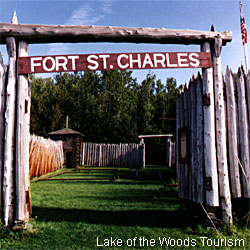
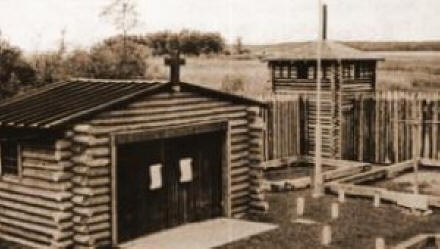
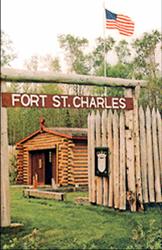
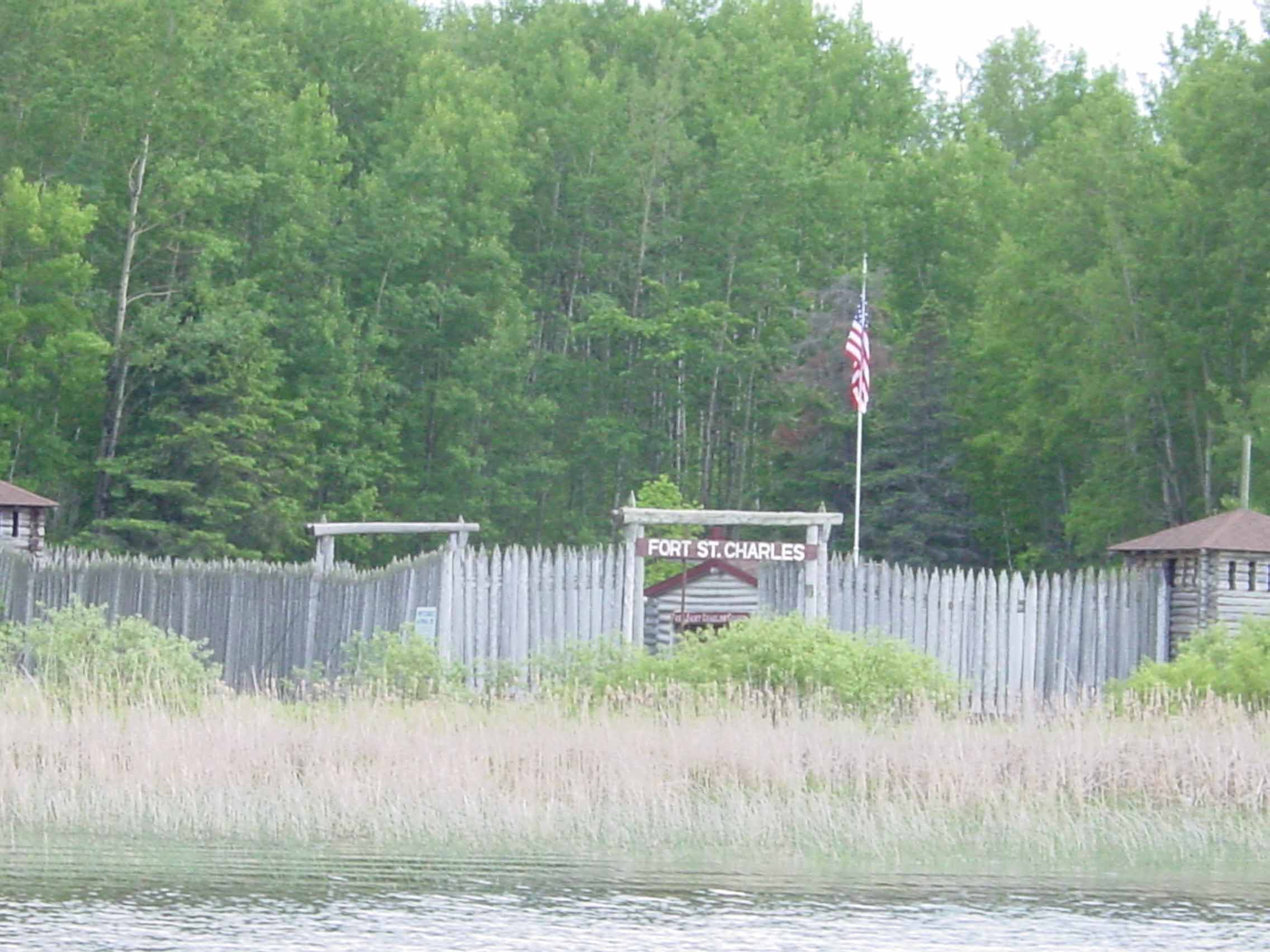
60th Anniversary June 9,
2009
Jim
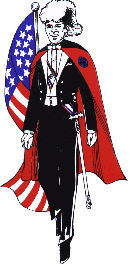

MN Fourth Degree Knights of Columbus
[Emblem Explained]
Contact:
Chairman Jim
Andrie 25103 Carousel Road Paynesville MN. 56362.
Home phone
(612)-845-8319
email:
jim.andrie@hotmail.com
The Restoration
Historic Fort St. Charles was restored in 1950 by the Minnesota
Fourth Degree Knights of Columbus, who have contributed funds, time and hard physical
labor under primitive conditions to clear the site and permanently mark it with a Memorial
Altar and later a Chapel of pre-cast concrete logs. Title to the property through their
efforts was transferred to the Catholic Diocese of Crookston. It was dedicated on July
4,1951, by Bishop Francis J. Schenk.
The Fourth Degree Knights of Columbus has as its primary purpose
the instilling of a love of country and the duties of citizenship. Its motto is
"Patriotism enlightened and informed by religion."
Pierre Gaultier De Verennes, Sieur De La Verendrye
The Sieur De La Verendrye, an enterprising Canadian explorer and
fur trader, lured into the wilderness by Indian tales of a great "Western Sea",
established Fort St. Charles in the summer of 1732. Traveling by way of the Grand Portage
and Rainy River to Lake of the Woods La Verendrye made his headquarters at this spot and
from it built a chain of five or six other posts in the vicinity of Lake Winnipeg.
The Fort St. Charles Story
Restored Fort St. Charles occupies the exact site of the original
log fort and fur-trading post erected in 1732 by a valiant band of French voyageurs
commanded by Pierre La Verendrye who was born at Three Rivers on the St. Lawrence River on
November 17, 1685. It is located at the top of the Northwest Angle in Angle Inlet of
Lake of the Woods in Minnesota. This great inland lake with it’s numerous rock
islands and tree-covered shorelines gives these waters a primitive rugged beauty as
intriguing today as they were in the days of the early voyageurs who first braved
it’s unknown hazards more than two hundred and fifty years ago.
From Fort St. Charles other forts were established and a vast
section of mid-continent North America explored by Pierre La Verendrye and his four sons.
When originally built in the year 1732, the year of George Washington's birth, Fort St.
Charles was the most northwesterly settlement of white men anywhere on the North American
continent.
To Catholics everywhere, it is also a reminder of the earliest
missionary labors that occurred in what is now northwestern Minnesota. For more than one
hundred and seventy-two years the fort was the burial place of the youthful Father Jean
Aulneau, S.J., and his nineteen French companions massacred on a nearby island in Lake of
the Woods on June 6, 1736.
The Story (continued)
http://www.netreader.com/kenora/thomson/index.html
(All photographs on this page are Copyright (c) Tom Thomson
All rights reserved)
Plaque To Be Installed Fall of 2008 Dedicating
Cabin #2 to Dad!
Fall Work Crew: 'Dan
James'; 'Jim Andrie; Dennis Boeckers'; 'George Althoff'; Peter Beckel; 'Rick
Skalsky'; 'Timothy F. Paquin'
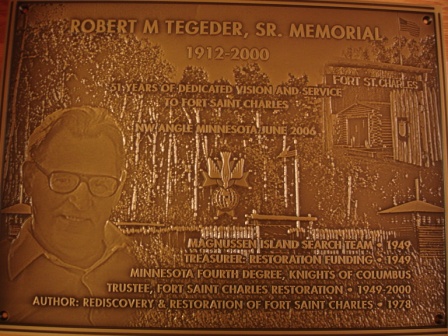
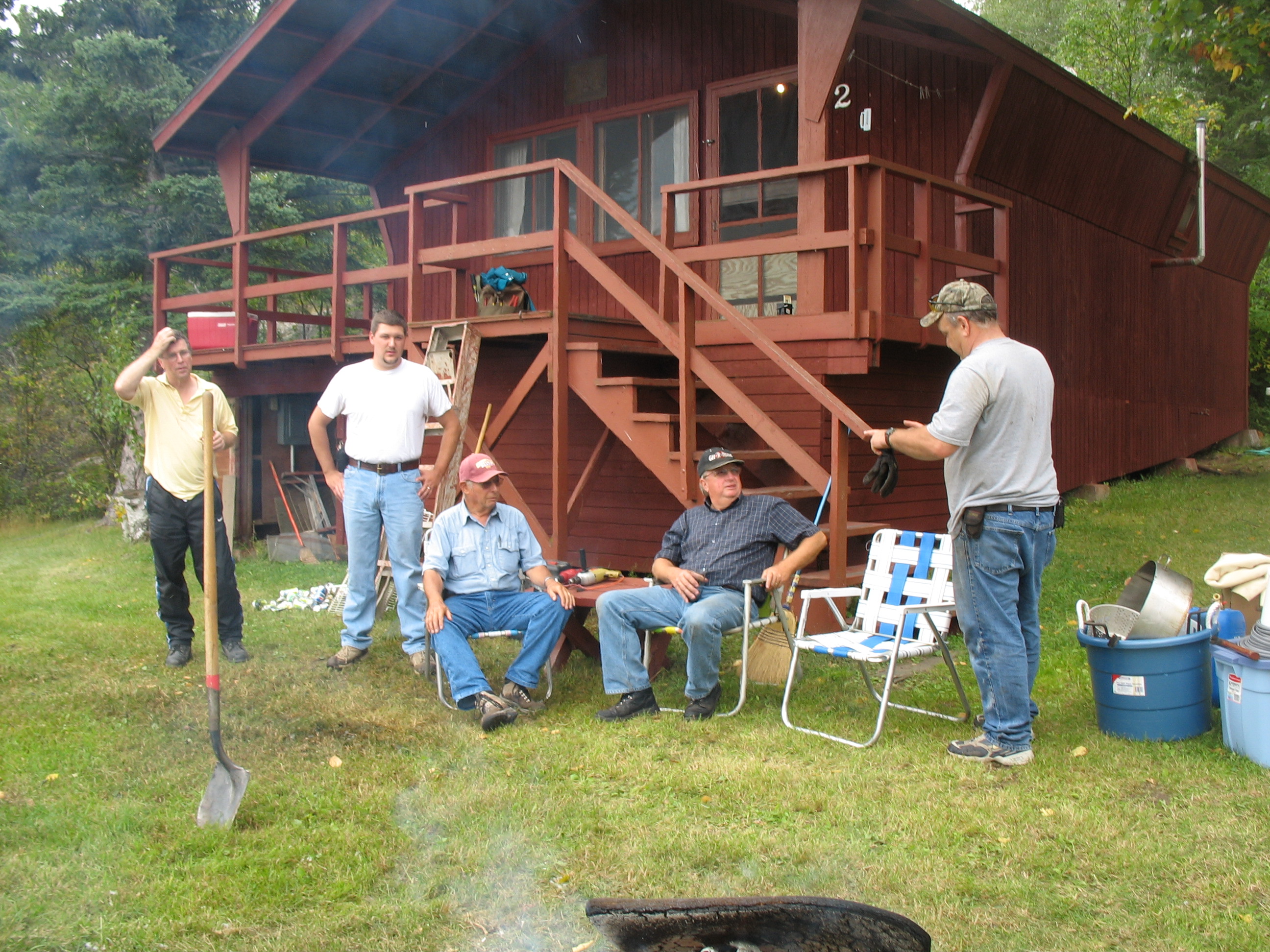
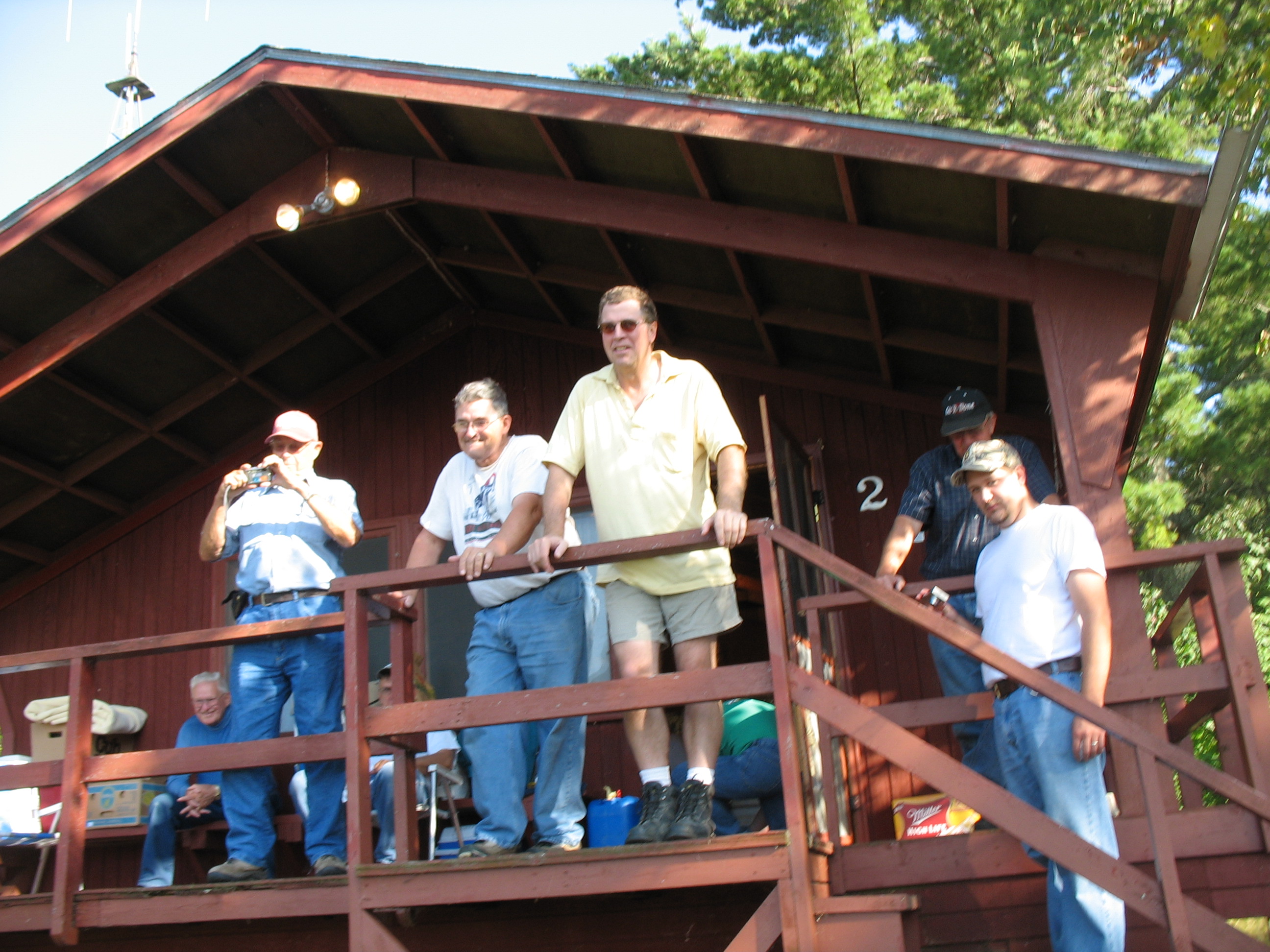
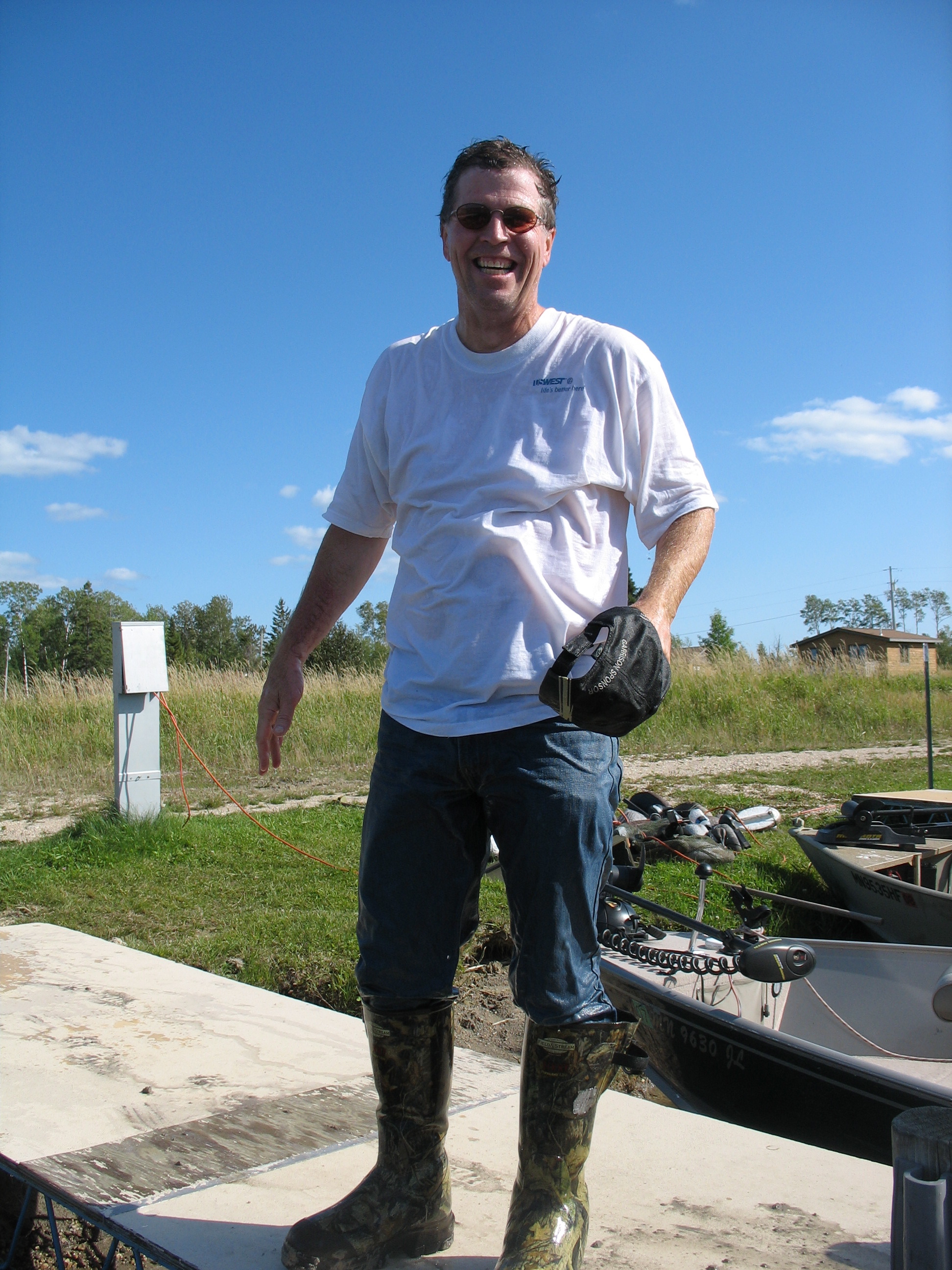
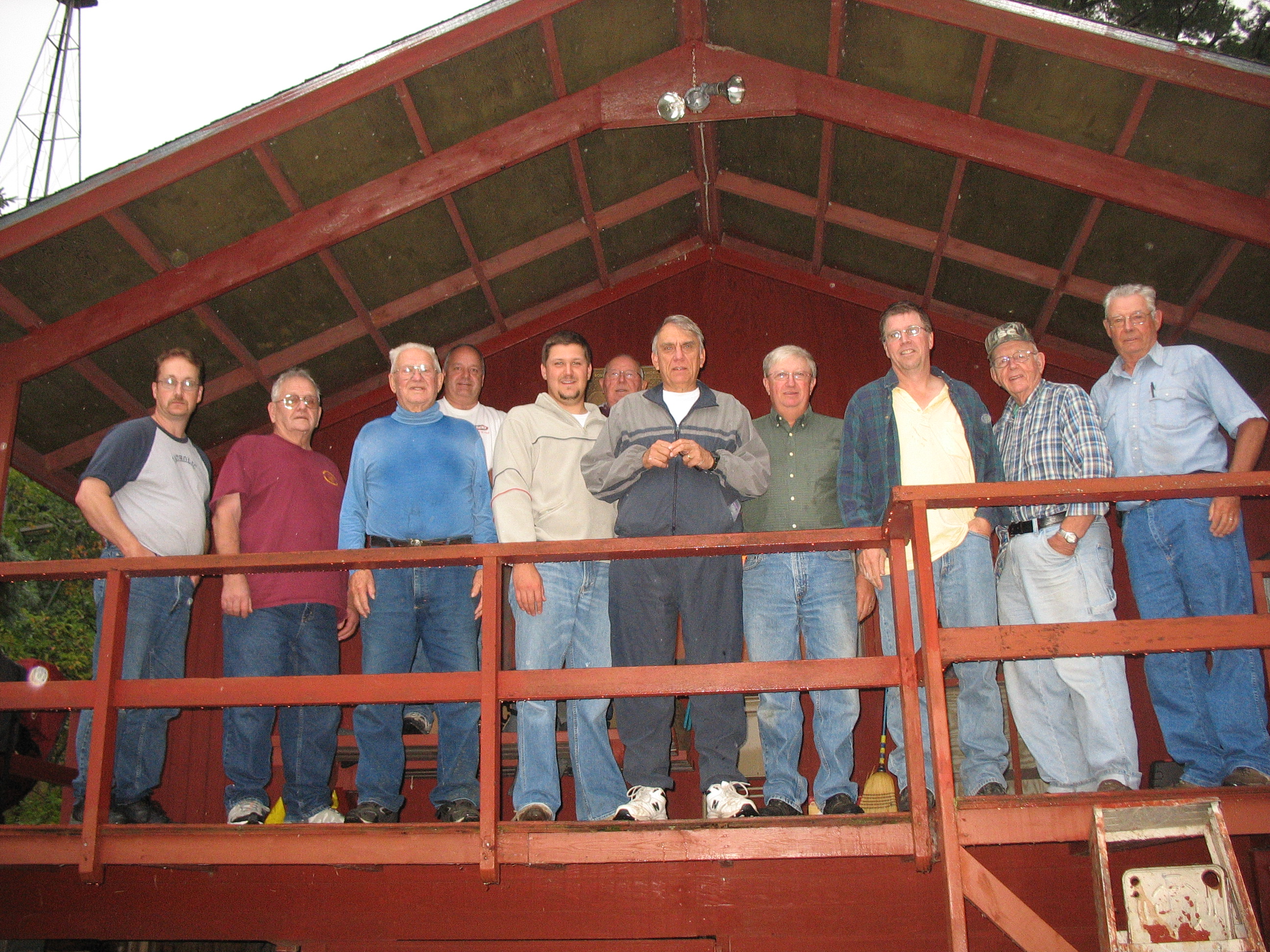

The MINNESOTA FOURTH DEGREE KNIGHTS OF COLUMBUS began the
restoration of Fort St. Charles in 1949. This statewide activity and their continued
maintenance of the site on Magnusson Island will insure that Fort St. Charles will remain
a shrine to all Christians and historians. It will be visited again and again by all those
seeking solace and inspiration in the midst of the beauties of a primeval wilderness near
the sparkling waters of beautiful Angle Inlet.
A visit to the site of Fort St. Charles and recalling all that
occurred there so long ago also serves to remind us of the dedication and accomplishments
of Pierre Gaultier de Verennes, the Sieur de La Verendrye. (Full Title) He was the first
native-born Canadian to penetrate the unknown lands west of the Great Lakes and his
discoveries have deservedly earned for him for all time the title of "Pathfinder of
the West."
When La Verendrye led his companions from Lake superior westward
through the boundary waters to Lake of the Woods in June of 1732, only Indians roamed the
plains, rivers and mountains between the Great Lakes and the Pacific Northwest. Alaska was
then unknown and undiscovered. Any white man had not as yet visited the continent's
western shoreline, in its northern reaches. In this same year 1732, Vitus Bering was in
St. Petersburg preparing for his voyage from the Kamchatka Peninsula. That trip resulted
in the first sighting from sea of the northwestern coastline. Other than a small
settlement of English fur traders on the southeast shore of James Bay and another small
group of Frenchmen at Fort Beauharnois on the Mississippi at Lake Pepin to the south, no
other white settlement or post occupied any part of the vast and unknown lands between the
Missouri River and the Pacific Ocean. This was the land that awaited the explorations and
canoes of the La Verendrye family in 1732.
From 1732 to 1740, with Fort St. Charles as his primary base, La
Verendrye explored all of present-day Manitoba south of Norway House on Upper Lake
Winnipeg and from The Pas westward into Saskatchewan.

From Lake of the Woods he and his sons paddled their canoes up
the Red and Assiniboine Rivers, down the Winnipeg, across to the Souries. They traveled to
the Great Plains through present -day North and South Dakota and for hundreds of miles
along the Upper Missouri River to become the first white men of record to visit the Mandan
Indians and the members of other plains tribes. They were also the first to reach the
foothills of the Big Horn Mountains in northern Wyoming.
Accounts of these explorations are contained in La Verendrye's
own journals, kept during the years he commanded at Fort St. Charles. The first visit to
the Mandans on the upper Missouri, occurred in 1738-sixty years before the Lewis and Clark
expeditions in 1804. Two of the explorers sons, Francois and Louis-Joseph, led an
expedition westward again in 1742-43and were the first French to penetrate the territory
beyond the Missouri River. They were absent on this journey for more than a year,
exploring all the country west along the great river and reached the foothills of the
Rocky Mountains.
Today, the restored Fort St. Charles is included on the NATIONAL
REGISTER OF HISTORIC PLACES, and is considered one of the most important historical sites
in Minnesota by true historians. It includes the remains of a mid-eighteenth century
French outpost and other components representing early historic and prehistoric Indian
occupations. It is also significant both as an expression of early European colonialism
and exploration in the northwest and is a unique source of archeological information
relating to its establishment and use.
Douglas A. Birk, Chairman for the Institute for Minnesota
Archaeology, conducted a preliminary archaeological search at Fort St. Charles during the
1970's. He reported that the site is of "National Significance." In discussing
his findings, Birk said, "For years Fort St. Charles was La Verendrye's principal
headquarters and depot and the rendezvous point for numerous Crees, Monsoni and
Assiniboine war parties who ventured southward to raid the Dakota tribe. Fort St. Charles
was the point of departure for some of the most westerly explorations of its time and its
use and maintenance helped lay the foundation for later development of the Northwest under
the British. The fort was finally abandoned in the mid1750's when eastern wars forced the
French to withdraw from the area.
To add to its distinction and historic importance Fort St.
Charles today is just one of three pre-1763 French fort sites that have been found in
Minnesota and it is the only one that is positively identified by name. Fort St. Charles
was the longest occupied French post in Minnesota and is the only French fort in the state
where remains of a contemporary Indian habitation area have been located nearby. The
significance of Fort St. Charles as a center for early French exploration, trade,
diplomatic and missionary efforts is today matched only by its importance as a material
repository for archaeological information."

1732- LA VERENDRYE BUILDS FORT SAINT CHARLES
Leaving Montreal by canoe in the Spring of 1731, La Verendrye and
his company of fifty companions including three of his sons, paddled up the St. Lawrence
and Ottawa Rivers and by numerous portages reached Georgian Bay and then French Post at
Michilimackinac (present-day Mackinac Island).
Father Charles Mesaiger, S.J., who was to serve as their Chaplain
and also as a missionary to the Indians they might encounter, joined them. After a few
days rest, they paddled along the shores of Lake Superior to the furthest west outpost,
Fort Kaninistiquia, now Fort William, Ontario. They then proceeded to the Grand Potage
Bay, which they reached on August 26th, after some three months and a thousand
miles of paddling since departing Montreal.

http://www.bwca.org/cv/canoetrips.html
The canoes used by the French voyageurs were of Birch bark
25 to 30 feet long, 4 to five feet wide. Each carried eight-ten men who were allowed a
forty-pound bag of personal possessions each. In addition, each canoe had a cargo of sixty
pieces of merchandise weighing 90 to 100 pounds a piece; a total load of about four tons.
Frequently the canoes were towed upstream or both cargo and canoe transported by hand
during portages. In one 20 mile stretch for example, the goods had to be unloaded and
reloaded seven times and four of these times the canoes themselves had to be carried.
At Grand Portage on Lake Superior, some of his men, fearful of
the unknown and the approach of early winter balked at continuing the journey into the
interior. La Verendrye then sent his oldest son Jean-Baptiste and his nephew La Memmeraye
with a few men to travel the boundary waters to Rainy Lake and there build a trading post
for fur trading with the Indians. The small group built Fort St. Pierre near the present
site of Fort Francis, Ontario and the remainder of the party with La Verendrye returned to
Fort Kaninistiquia where they spent the Winter months of 1731-32.
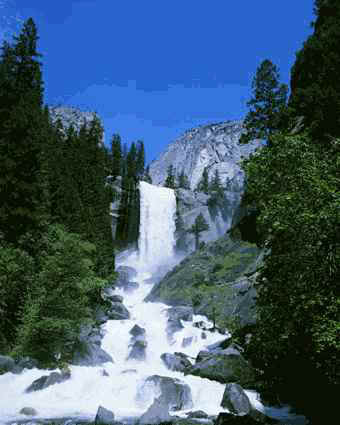
The advance party returned in the spring of 1732 to Kaninistiquia
reporting the Indians friendly. The expedition then proceeded over the long nine mile Grand
Portage Carry around the Falls of Pigeon River and then through the border lakes.
It was some 225 miles to Fort St. Pierre and then 150 miles by way of the Rainy River to
the western shore of Lake of the Woods where Fort St. Charles was constructed in Angle
Inlet. This was the first expedition to travel the Indian trail through the boundary
waters between Lake superior and Lake of the Woods. The route, with its portages,
connecting rivers and numerous lakes, is the popular Voyageur route still in use to this
day.
The new fort was named St. Charles in honor of the Marquis
Charles de Beauharnois, then Governor of French Canada and also in honor of Father Charles
Mesaiger, S.J., the Jesuit missionary.
THE FORT LOCATION
Situated on the south bank of the Angle Inlet, it was built of
four rows of timbers about fifteen feet high. It was 100 feet in length and 60 feet wide
and had four towers.

Within this enclosure was a log cabin for the commanding officer,
one for the missionary, a gunpowder magazine, a warehouse and four corner houses and two
gates which were opposite form each other.
As his fur brigades passed over the route from Lake of the Woods
to Lake superior they improved the numerous portages and the course that they had followed.
It
is the international boundary between Ontario and Minnesota today. For more than a century
this route that he blazed was the only road of travel for all those venturing westward
from Lake Superior.

Indians came to Fort St. Charles to barter their furs. La
Verendrye also induced some of them to settle near the fort and taught them to sow corn
and peas, thus becoming the first agriculturist in the Midwest. Activity at Fort St. Charles flourished. In 1733 La Verendrye
sent his nephew La Memmeraye to Montreal and Quebec with official reports of his progress
and a request for additional supplies. Father Mesaiger, because of failing health,
returned east with him. In the summer of 1734 Fort Aux Rosseaux was established on the Red
River and in the fall, Fort Maurepas was built on Lake Winnipeg.
THE MASSACRE
That same year La Verendrye himself returned to Montreal for
financial help. He departed Montreal in May of 1735 bringing his youngest son and Father
Jean Pierre Aulneau to fort St. Charles.
That winter of 1735 was one of trouble for the small group
at Fort St. Charles. Expected supplies did not reach the fort before ice closed the lake.
The harvest of wild oats (rice) was a poor one. La Jemmeraye on an inspection trip to fort
Maurepas and fort Aux Rosseaux during the winter became ill, died and was buried on the
banks of the Red River in May of 1736. Jean-Baptiste La Verendrye, the 21-yar old son of
the explorer, succeeded him as second in command.
The situation at the fort became so desperate that in the
spring with only spoiled fish remaining for food, La Verendrye decided to send to
Michilimackinac for supplies, though word of a Sioux war party in the area disturbed him.
Father Aulneau asked to make the trip and Jean-Baptiste was the expedition's leader. On
a small island some fifteen miles from Fort St. Charles all were surprised and massacred
by the Sioux and beheaded. Later the bodies of father Aulneau and Jean-Baptiste and the
heads of the other Frenchmen were returned to fort St. Charles and buried under its crude
altar within the stockade.

Despite this tragedy and other discouragement's confronting him,
Pierre La Verendrye did not end his explorations. As a peacemaker, he did his utmost to
diffuse the warfare between the Sioux and the local Indians. The loss of his men and the
lack of supplies prevented further exploration for a year until he could go again to
Montreal, face his creditors and re-equip with more men and supplies.
 1737-1749
1737-1749
During 1737 he built Fort rouge at the junction of the Red and
Assiniboine Rivers at the site of present day Winnipeg. In 1738 he proceeded west,
visiting the forts already established and then he built Fort La Reine where the city of
Portage La Prairie now stands. As soon as this fort was completed he started out on foot
across the plains for the land of the Mandans. With an Indian escort this trip took a
month and a half and he recorded pertinent facts of the trip in his journal. It was while
at the Mandan towns that La Verendrye learned of additional tribes and rivers farther to
the west. The lateness of the season, desertion of an interpreter and the loss or theft of
his trade goods prevented further exploration. On the return march he became ill and
barely reached Fort La Reine.

In 1740 he made another trip to Montreal returning to Fort St.
Charles in 1741. During this summer season he continued the explorations of the
Saskatchewan River, established Fort Dauphin on the northwest shore of Lake Manitoba and
Fort Bourbon at the mouth of the Saskatchewan (Cedar Lake). Later Fort Le Pas was built on
the site of today's The Pas and Fort LeCorne at the forks of the North and South
Saskatchewan Rivers.
TO THE BIG HORN MOUNTAINS

In 1743 he sent two of his sons to retrace his trip to the
Mandans and explore beyond that country. The brothers met the Horse Indians and through
them the Bow Indians with whom they traveled along the course of the Missouri river until
the Rocky Mountains were sighted. These were the Big Horn Mountains, 120 miles east of
Yellowstone Park. Returning by another route, they buried a lead plate on a hill near the
site of the village of the Little Cherry Indians. This was found on Sunday February 16,
1913 by children at the edge of the city of Pierre, S.D. This journey was the high water
mark of the La Verendrye explorations-their furthest western penetration!
DISGRACE REINCARNATION AND DEATH
Late in 1743 La Verendrye was forced to return to Montreal to
face charges of envious men who accused him of enriching himself from fur trade and by his
outfitters to whom he owed 40,000 livres after sacrificing all his own property.
Confronted by these obstacles he resigned his command. Later vindicated, he was restored
to leadership and was organizing a new expedition to the northwest when he died December 5th,
1749 in Montreal.
MEMORIES FADE AND THE CLUE TO THE PAST IN A LIBRARY IN FRANCE
Later commanders of the western forts made no provisions for La
Verendrye's sons and they, after a few years in the west returned to eastern Canada. At
the beginning of the Seven Years War in1758, fur trade ceased and at its conclusion the
British took over Canada. The exploits of the La Verendrye were forgotten and fort St.
Charles was abandoned and its site reverted to the wilderness. A decade passed before his
dream of an overland route to the Pacific Ocean was realized.
The story of Father Aulneau, which came to light in France in
1889, was responsible for a search of old records which brought into prominence an
appreciation of the greatness of Pierre La Verendrye and the historical importance of Fort
St. Charles.
FATHER AULNEAU, MARTYR
1705-1736
Father Jean Pierre Aulneau, S. J., was born in Vendee, France in
the manor of the Aulneau family, on April 21st, 1705. Two of his brothers were
ordained priests and one of his sisters became a nun. At the age of 29 he left France to
serve as a missionary in the New World. On board the ship sickness broke out and he was so
self -sacrificing and zealous in his care of those stricken with disease that a companion
Jesuit wrote home, "God preserved his health for the consolation of those
aboard."
Upon landing at Quebec he himself became ill. Many weeks later he
recovered his health and spent the winter of 1734-35 preparing for his ordination, which
took place in April. Shortly thereafter he was assigned as missionary with La Verendrye's
expedition. He was to go to Fort St. Charles, spend the winter there and learn the Cree
and Assiniboine languages, preparing a written list of words so that a dictionary could be
compiled.
One difficulty of converting the Indians of the West was
their habit of wandering from place as they hunted and trapped. Some progress would be
made with a band only to have them fade into the wilderness for months or years at a time.
Their superstition, moral laxity, and the liquor provided them by avaricious traders (a
practice, Father Aulneau reported, which La Verendrye had forbidden his expedition to use)
were other difficulties.

Friendly Indians had told La Verendrye of a tribe many days
journey to the southwest of Fort St. Charles who lived in earth huts in permanent towns.
These were the Quantchipouanes, which are "the people who live in holes." Father
Aulneau was instructed to find this tribe, the Mandans, whom no white man had seen and
teach them the Gospel. This assignment was in the words of a fellow Jesuit, "the
longest most painful and dangerous journey ever undertaken by a missionary in
Canada."
Father Aulneau dreaded most the loneliness -spiritual
loneliness- for several hundred leagues would separate him from another priest. He knew
that death was a possibility but wrote, "I should deem myself happy if I should be
worthy of laying down my life of the One from whom I received it." Leaving Montreal
with La Verendrye on June 21st, they reached Fort St Charles Sept. 6th
1735.
One of Father Aulneau's letters written in April 1737 tells of
his intention to spend the summer with the Assiniboines at Lake Winnipeg and about All
Saint's Day (Nov 1 st). He would accompany them, with any Frenchmen who were willing to
search for the tribes his Superior wished him to find.
This plan was never realized.
After the trying winter when La Verendrye decided to send canoes
for supplies, Father Aulneau asked to accompany them so that he might consult another
priest while the opportunity offered. With 20-year-old Jean-Baptiste La Verendrye in
command of three canoes and 19 men they set out from Fort St. Charles on June 5th,
1736. On an island some 20 miles away the Sioux killed all of the party. Father Aulneau's
beheaded body was found propped in a kneeling position. It was returned to Fort St.
Charles with that of Jean-Baptiste, La Verendrye and there buried in the chapel.
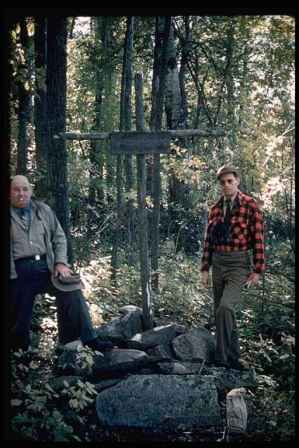
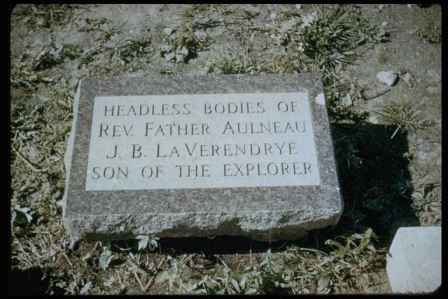
Site of the original grave found in1908
(Mr. Joseph Moskowlik and Robert M. Tegeder)
THE REDISCOVERY AND RESTORATION OF FORT ST. CHARLES
Some years after the death of Pierre La Verendrye in1749 Fort St.
Charles was abandoned. A few years later the French and Indian War and the surrender of
Canada to the British ended the French fur trade and exploration in the west. With its
official records filed away in governmental archives, Fort St. Charles was soon forgotten.
Nature and the elements soon obliterated the stockade and buildings of the little fort on
the island in Angle Inlet of Lake of the Woods. With the passing of more than a century
and a half, knowledge of its location remained only in old Indian tales and in French and
Jesuit archives.
Fate then intervened and a series of unusual incidents brought to
light the story of Father Aulneau, Minnesota's martyred priest. Also, the rediscovery of
the fort itself by Jesuit Fathers in 1908; the permanent marking of the site in 1950 and
restoration of the fort in 1960 by the Minnesota Fourth degree Knights of Columbus
occurred.
During Advent in 1889 three Jesuit priests gave a mission in
Vendee, France. As it ended, an old man named Aulneau approached the priest saying that
they were the first Jesuits he had seen although some generations before a member of his
own family had become a Jesuit priest and was slain by Indians in North America. He told
of letters from this young priest preserved as heirlooms in his family for over a hundred
and fifty years. The missionaries obtained the letters, which were copied and translated
into English. Later the story and letters were published in THE CANADIAN MESSENGER,
a widely circulated Jesuit magazine, and also reprinted in a book edited by Rev. Arthur K.
Jones, S.J., that appeared in 1893, entitled THE AULNEAU COLLECTION OF LETTERS.
Then Jesuits at St. Boniface College (across the Red River from
Winnipeg) interested themselves in the Aulneau letters and in the summer of 1890 organized
an expedition to search Lake of the Woods to locate Fort St. Charles and to recover the
body of father Jean Pierre Aulneau, S.J. This first expedition visited the area but was
unsuccessful in finding the fort, as were other similar expeditions in later years. Then
in 1908 an expedition sponsored by Archbishop Langevin of st. Boniface, composed of
professors and others from St. Boniface College and led by Father Paquin, S.J., camped on
American Point Island, which is the island adjacent to Magnusson Island in Angle Inlet of
Lake of the Woods.
Here another incident occurred. Father Paquin cut his foot with
an axe. While others in the party searched the north shore of the Inlet, he re-examined
the notes of earlier expeditions while confined to camp and studied in particular the
statements of old Chief Powassin, since deceased. He became convinced that the old Chief
had said that the crumbled chimneys he had seen as a boy were near a cove opposite and
west of the fireplace on the north shore. The next day the entire party coasted
westward along the south (United States side) of Angle Inlet and soon reached the cove as
described by Chief Powassin. Here they landed and formed a line to beat through the dense
forest that then covered Magnusson Island. Advancing only a short distance, flat chimney
stones were soon found; then fireplaces. Axes and shovels were put to use; trees and brush
cleared; and soon the stumps of an old stockade were disclosed-Fort St. Charles had been
rediscovered.
Later that summer with official witnesses the site was
methodically trenched mapped and photographed. Bones and nineteen skulls of the voyageurs
were found; then the bodies of Jean-Baptiste La Verendrye and Father Aulneau. After
positive identification the bones of father Aulneau and the others were moved to St.
Boniface College. A cross with a wooden plague was left to mark the site of Fort St.
Charles and during the following years the site was rarely visited and again soon reverted
to wilderness. And thus it remained for another forty-two years.

In the spring of 1949 Dr. Paul E. La Fleche, Fourth Degree Master
of Winnipeg, suggested at a Master's meeting held in Chicago to George F. Parkos, Master
of the Minnesota Fourth Degree that clearing and permanently marking the site of Fort St.
Charles would be an appropriate project for the Minnesota Fourth Degree to mark the 50th
anniversary of the establishment of the Fourth Degree in the State.
This conversation resulted in investigation during the
following months and state Master then named the following committee to investigate the
possibility of inaugurating such a project. The committee included:

Saint Paul, Minnesota
A.L.Grabenstetter
Henry E. Huot
William H. Fallon
Minneapolis, Minnesota
Gilbert Bauer
N.M. Coursolle
Robert M. Tegeder
Hibbing, Minnesota
Victor J. D'Andrea
Mankato, Minnesota
Joseph A. Young
Saint Cloud, Minnesota
Lawrence J. Borgert
This Golden Anniversary Committee after careful study recommended
to the Minnesota Fourth Degree Knights of Columbus that the site should be permanently
marked and that a granite altar erected there in honor of Father Jean Aulneau, S. J.
At this same time the Rev. Emmett A. Shanahan, pastor of St.
Mary's parish, at Warroad, Minnesota had conceived the idea of erecting a father Aulneau
Memorial Church at Warroad. With the permission of his bishop, Francis J. Schenk of
Crookston, he undertook the task. He had written, "Minnesota's Forgotten
Martyr," a pamphlet vividly telling the story of father Aulneau and of the massacre.
The friendship that developed as a result of this joint effort resulted in a close
association that existed until the time of father Shanahan's death in 1960. Father
Shanahan's help and advice was invaluable to the Sir Knights in the improvement and
rebuilding plans for the fort.

In 1951 work groups of Fourth Degree Knights with only hand tools
felled trees and cleared brush, hand mixed concrete for the altar base and erected the
memorial altar. Bishop Francis J Schenk celebrated Mass and dedicated the altar on July 5,
1951. At this dedication the Bishop was presented a deed conveying the Fort St. Charles
forty-acre site to the Catholic Diocese of Crookston.

Much legal work had been necessary and a special act of the State
Legislature required to obtain a clear title to the property. In 1952 the site was further
improved and in 1953 the Chapel of pre-cast concrete logs was erected to shelter the
Memorial Altar. The graves of Father Aulneau, of Jean Baptiste La Verendrye, and of the
remains of the other voyageurs were outlined and marked. The first cabin was erected in
1955 and two additional cabins built in 1966. These cabins have been completely furnished
and are presently reserved for the exclusive use of vacationing members of the catholic
clergy, free of charge.
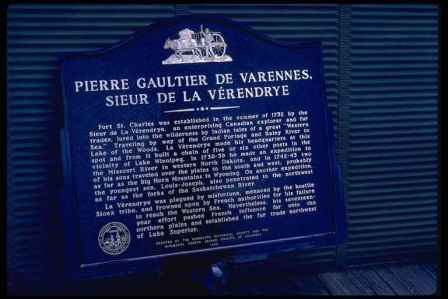
To facilitate the landing of large boats, a barge was towed
from the Warroad River in 1955 and anchored along the shore to serve as the fort landing.
This served its purpose for many years, but was replaced in 1984 with portable docks that
can be removed at the end of each summer season. Through the years the entire area has
been landscaped and improved, shrubbery planted, and a park-like appearance of the fort
area between dock and fort achieved.






The fort stockade and corner bastions were erected during the
summer of 1960, after a thorough research of old journals and records. It stands on the
exact outlines of the original fort and closely resembles the descriptions also found in
the old records. Within the stockade the known buildings with fireplaces have been
indicated by pipe markers and the former graves of Father Aulneau and of his companions
marked with proper headstones.
THE RESTORED SITE AS VIEWED FROM ANGLE INLET

ADMINISTRATION
The FORT SAINT CHARLES TRUSTEES direct the administration of
the site. The State Masters appoint these Sir Knights and they are responsible for its
maintenance and for the continuation of the program of historical preservation. Work
groups visit the fort each spring and fall to continue the work of earlier committees and
to complete the maintenance, repair and chores that require expert attention. Progressive
clearing of the encroaching forest continues, major additions and improvements are added
as finances permit and a guest register maintained for the thousands of visitors who visit
the isolated island location each season.
The project of restoration is financed entirely by the
Minnesota Fourth Degree Knights of Columbus, through voluntary assessments contributed by
the various state assembles. It is a splendid tribute indeed to the Minnesota Fourth
Degree that all has been accomplished without any state or federal grants or subsidies. No
tax monies have been expended on the project. The project is one of the most ambitious
historical restorations undertaken anywhere by a private fraternal organization.
Succeeding committees during the years since 1950 have
continued the work of restoration and upkeep. Former chairmen of the restoration project
include: Al Grabenstetter of St. Paul former PSM George Parkos of New Prague and former
PSM Raymond Gleason of Minneapolis. Robert M. Tegeder, of Apple Valley, Minnesota has been
associated with the restoration since 1949 and served as Chairman of the Trustees from
1972-1978.

SUGGESTED ADDITIONAL READING
For those interested, information as to the history of Fort St.
Charles or about the lives of Explorer La Verendrye and his sons, and those of Father
Aulneau, S.J. consult the following books available at major libraries or historical
research centers:
JOURNALS AND LETTERS OF PIERRE GAULTIER DE VERENNES DE LA
VERENDRYE AND HIS SONS, The Camplain Society. Lawrence J. Burpee, Ed., 1927
LA VERENDRYE, HIS LIFE AND TIMES. By Martin Kavanagh.
Fletcher and Son, Ltd., Norwich, England, 1967
EXPLORATION OF THE LAVERENDRYES IN THE NORTHERN PLAINS,
1738-43, University of Nebraska Press, 1980.
REDISCOVERY AND RESTORATION OF FORT ST. CHARLES. St.
John's University Press, Collegeville, MN, December, 1978 by Robert M. Tegeder

History/Lake of the
Woods
Video



FREE CABINS FOR VACATIONING CLERGY
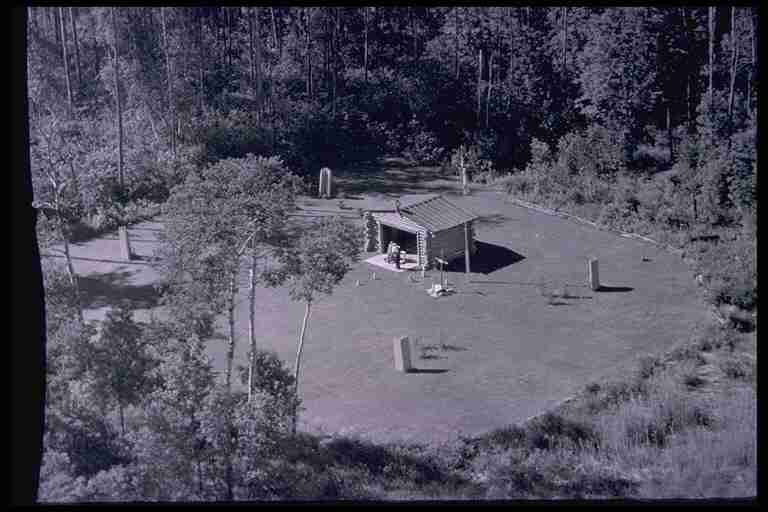
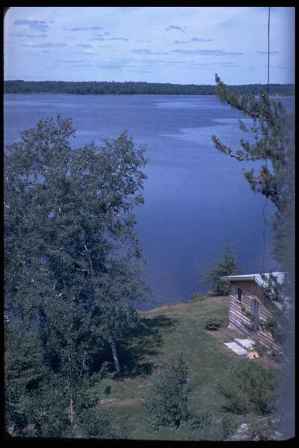

FOR MEMBERS OF CLERGY ONLY
The Minnesota Fourth Degree Knights of Columbus provide cabins at
Fort St. Charles free. Each is complete with housekeeping equipment and sleeping
accommodations for four persons. Boats with outboard motors are also provided. Length of
stay for groups of two or more for any period not exceeding two weeks. Cabins have running
water, electric appliances, chemical toilets and wood burning stoves for heating on cool
nights.
The cabins are located on Magnusson Island, within easy walking
distance to the fort site and are about two miles by water from the ANGLE OUTPOST RESORT
on the NW Angle, or about five miles by water from the resorts at Angle Inlet Village. The
Angle Outpost Resort also operates a small store for the convenience of cabin residents
and vacationers in the area. Clergy using the cabins may also park their autos at the
Angle Outpost Resort during their stay at the fort. Mass may be celebrated on the Father
Aulneau Memorial Altar in the Fort St. Charles chapel. This is located within the fort
palisade, on the actual site of the original fort chapel. For reservations for use of the
cabins and full information, send inquiry to:
Contact:
Chairman
Jim
Andrie 25103 Carousel Road Paynesville MN. 56362.
Home phone
(612) 845-8319
email:
jim.andrie@hotmail.com
HOW TO REACH FORT ST. CHARLES
The only road access to the village of Angle Inlet is from the
hamlet of Sprague, on Road No. 308 in the Province of Manitoba, available from Warroad,
Minnesota. Thus all visitors to this remote area by auto must drive through a portion of
Canada to visit or vacation in the Northwest Angle country.
It is possible for large private boats to reach Fort St. Charles
from Warroad, the only American port on Lake of the woods. Plane service is also available
from Warroad for the round-trip visit to the fort, as well as for visits to the resorts at
Angle inlet and on Flag and Oak Islands, on the American side of the lake.
There is regular boat service also from Kenora in Canada to Flag
and Oak Islands, including a stop at Fort St. Charles on the American side, and small
private boats can easily make the trip to the Fort from the resorts in the area, or from
Kenora, Sioux Narrows, or from Nestor's Falls, Ontario. There is no public boat
transportation from Warroad, however.
The map shows the auto road from Warroad to the border where a
stop must be made at Canadian Customs. Then on to Sprague where a gravel road leads to
angle inlet as shown and to the resorts in that area. There are accommodations at Angle
Inlet and at the Angle Outpost resort. Located on the inlet just two miles by water from
the fort, as well as at all other resorts in the area.
The resorts have boats and motors for rent, as well as modern
clean housekeeping cabins, boat ramps and numerous camping and trailer sites. There is
also an approved 2,640 foot sod airstrip at the northwest Angle Resort and float planes
can land in the inlet in front of the fort itself. There are ample tourist accommodations
at both Warroad and at Angle Inlet, with numerous marina and launch services available.
Distances by auto from various areas to the angle Inlet are:
120 mile from Winnipeg
170 miles from Grand forks
500 miles from Sioux Falls
700 miles from Omaha
325 miles from Duluth
700 miles from Chicago
120 miles from Thief River Falls
245 miles from Fargo
600 miles from Sioux City
425 miles from Minneapolis/St. Paul
FORT ST. CHARLES TRUSTEES 1988
Henry B. Langenfeld Joseph Donnelly
George Vadnais Jerry Stefanich
John J. Kimlinger Paul Beckel
Albert J. Collyard Dick Babler
Michael N. Deutsch John Andrie
Joseph Berschens
Robert M. Tegeder, Chairman, Apple Valley,
MN.
FORT ST. CHARLES TRUSTEES 1997
Paul Beckel, Chairman
Albert Collyard
Dick Babler
Jim Patrick
Robert M. Tegeder
Dan De Crans
Frank Osendorf
James Andrie
Harry Dahlin
2008
FORT ST. CHARLES PROJECT
|
State Master
|
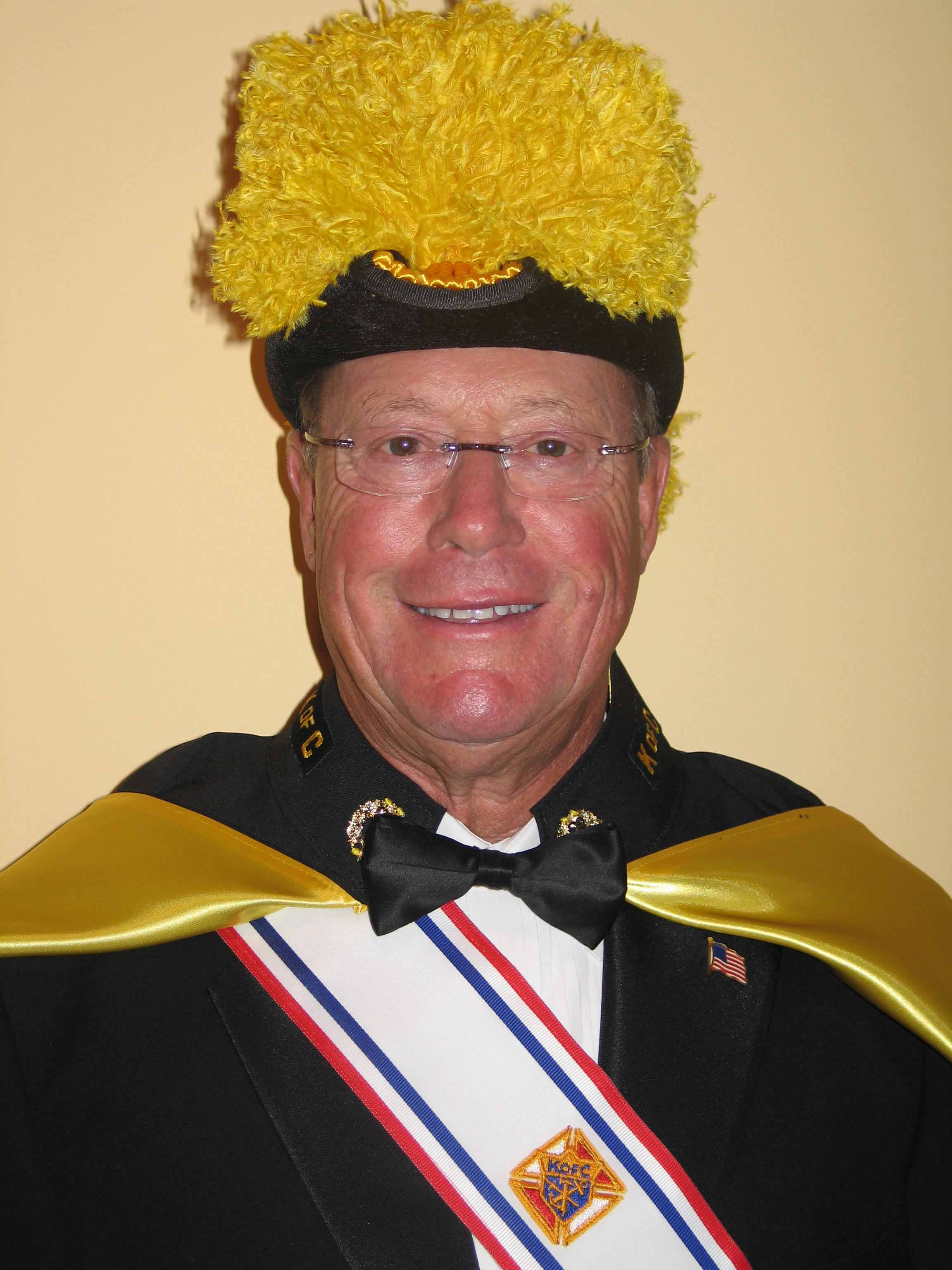
TOM GRINNELL (Jan)
(763) 479-1159
E-MAIL
|
|
Chairman
|
JAMES ANDRIE (612)-845-8319
E-MAIL
|
|
Fort St. Charles Trustees
|
|
Trustee
|
|
Trustee
|
DAVE KRAEMER
(218) 631-1028 |
|
DICK BABLER
(218) 442-6661
|
JOHN ANDRIE
(218) 631-2680
|
|
PAUL BECKEL
(218) 631-3236
|
DAN DECRANS
(218) 732-8813
|
|
JAMES ANDRIE
(612) 845-8319
|
HARRY DAHLIN
(218) 631-7046
|
|
BERNIE NIETFELD
(320) 987-3776
|
|
CONTRIBUTIONS TO THE RESTORATION FUND ARE WELCOME. Please
contact:
Chairman
Jim Andrie
Fort St. Charles Trustees
25103 Carousel Road
Paynesville MN. 56362. Phone is
(612) 845-8319

Historical Marker Warroad, MN
Fort St. Charles � Marker location: The
Point, at the end of Lake St. NE
Pierre Gaultier de Varennes, Sieur de la Verendrye,
established Fort St. Charles on Lake of the Woods in 1732. A daring
soldier, fur trader and explorer, la Verendrye had the ambitious dream of
finding the fabled �western sea� and sought to establish French outposts along
the way. On Magnusson�s Island (then connected with the mainland) he built
a palisaded fort which he named in honor of Charles de Beauharnois, governor of
New France. Fort St. Charles became the western capital of the French
empire in the northwest. From it expeditions were launched and supplies
dispatched to newer posts around Lake Winnipeg. Indians brought furs to
trade for white men�s goods and these pelts were sent by canoe to Montreal.
The scarcity of food and Indian warfare made life precarious. In 1736 la
Verendrye�s oldest son John Baptiste, 19 voyageurs, and Father Aulneau, a Jesuit
priest, were sent on an expedition to the east for supplies. They were
massacred by a Sioux war party on a nearby island.
Abandoned after 1760, the fort was rediscovered and marked by
a group of Jesuit fathers in 1908. The site was acquired and the buildings
reconstructed by the Minnesota 4th Degree Nights of Columbus some 40
years later.
http://www.netreader.com/kenora/thomson/index.html
(All photographs on this page are Copyright (c) Tom Thomson except Fort St. Charles
Photographs by Robert M. Tegeder
All rights reserved)
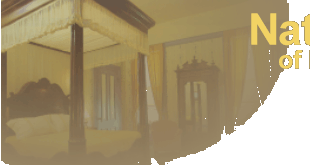

NRHP
| MINNESOTA -
Lake Of The Woods County |
 |
Fort St. Charles
Archeological Site
*** (added
1983 - Site - #83000911)
Address Restricted, Angle Inlet |
 |
|
Historic Significance: |
Information
Potential |
|
Area
of Significance: |
Historic -
Non-Aboriginal, Exploration/Settlement, Prehistoric,
Commerce, Historic - Aboriginal |
|
Cultural Affiliation: |
French |
|
Period of Significance: |
1700-1749,
1750-1799 |
|
Owner: |
Private
|
|
Historic Function: |
Defense
|
|
Historic Sub-function: |
Fortification,
Military Facility |
|
Current Function: |
Landscape
|
|
Current Sub-function: |
Park |
 |
|
|
ROBERT MARTIN TEGEDER SR.

Robert M. Tegeder has contributed an ongoing interest and
contribution to Fort St. Charles for over 48 years. His love of history and the exploits
and bravery of exploration has found a dedicated focus with the story of La Verendrye and
his three sons exploring uncharted frontiers with a dream of finding a passage to the
Western sea.
With deep Tegeder family roots in the Catholic faith and with
genealogical origins in Europe it is not surprising that the life of Father Aulneau holds
a certain fascination and reverence for him. This young Jesuit fresh from ordination
received an initial assignment to accompany explorers with the missionary assignment to
bring the Faith to the unknown Indian population of the Northwest. This young cleric ended
his life on his knees, the victim of a massacre by the very people he believed he was
there to save. Finding that all of this drama occurred in his beloved Northern woods of
Minnesota and nearby Manitoba the project was easily committed to by Robert Tegeder.
As the second of five sons and with a younger sister, the
neighborhood of North East Minneapolis found a young man of exceptional scholastic ability
and a genuine love for reading and history.
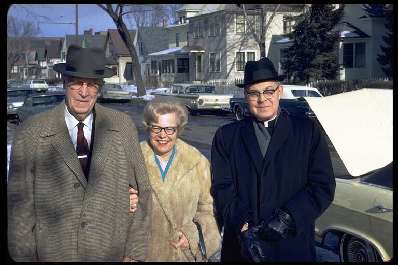
His older brother George (Father Vincent Tegeder OSB.) left
home at the age of 12 to enter the Benedictine seminary at St. John's in Collegeville, MN
where he went on to become the Head of the History department and Head Archivist of the
monastery. Their shared love of history and the scholastic pursuit has fueled their
friendship for over eighty years. All of the brothers and sister remain close and
supportive though separated by many miles in today's modern age.
Graduating from De La Salle, HS as the class salutatorian he
found himself with a four-year scholarship to Notre Dame University. While there he worked
for the administration and knew Knute Rockne and was instrumental in the writing of a past
President of the University's memoirs. Marriage, Service in the US Army in World War II,
employment by The Knights of Columbus, the birth of two sons and a daughter. followed.
Over the years he has supported the various charities in the Twin
Cities area and beyond and for years was dedicated to the visitation program for veterans
at The Old Soldiers Home along the Mississippi River. Every weekend saw he and at least
one of his children making the trip to the home to visit residents there. He was
instrumental in the beginnings of the youth basketball and sports leagues in the Twin
Cities and promoted the annual programs for The Boys Home. Over the years he has attended
the rosary and services for hundreds of fellow Knights of Columbus as well as many others.
His style of motivation extended to his home in that the love of
reading and the value of imagination were constantly being reinforced with historical
reference and colorful stories giving ordinary events and places a magical quality. Family
trips were planned for an entire year and the level of research was equivalent to a
thesis. The route would be mapped and the historical landmarks would be described and
discussed. The lessons of bravery and commitment and selflessness in the history of
mankind were highlighted and the origins of ones family and ancestors deserved immense
respect and interest.
He was instrumental in building Council 435 into one of the most
active and successful Knights of Columbus Councils in the United States. The charitable
works by this fraternal organization will never be fully recognized. In addition, the
founding one of the largest private Credit Unions in the State, managing a half million
dollar major building program, restoring Fort St. Charles, photo chronicling geographic
historical sites, authoring over twenty seven genealogical and historical publications,
travel to every state except Hawaii and Alaska as well as to Europe received his
attention. Providing support and inspiration to his friends, family, children and
grandchildren continue today.
THE PUBLICATIONS OF ROBERT M. TEGEDER SR. THRU 1996
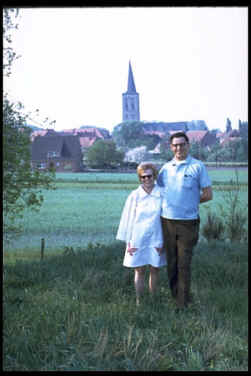
TEGEDER HISTORY - THE DESCENDANTS OF BERNARD WESSEL TEGEDER,
1964. 163 pages.
The book contains Photostats and German documents relating to the
family, including a copy of their official travel permit, Entlaffungs - Urkunde, issued by
the Prussian Government in March of 1874, along with family photographs. Binding by the
Miller-Davis Company of Minneapolis.
THE STORY OF FORT ST. CHARLES. As Chairman of the
solicitation committee to raise funds for the restoration of Fort St. Charles, author
wrote this article for mailing to all members of the Fourth Degree Knights of Columbus in
Minnesota in the spring of 1950.
FATHER JEAN AULNEAU OF FORT ST. CHARLES. A report of his
life in France and in New France, and as Chaplain and Missionary at Fort St. Charles
during the winter of 1735-36 and details of his massacre by Sioux Indians on an island in
Lake of the Woods in June of 1736, along with an explanation of how his letters sent to
his mother in France were miraculously discovered in 1889.
HISTORIC FORT ST. CHARLES. Brochure giving some history of
the explorer La Verendrye and of his expedition made over the boundary canoe route to Lake
of the Woods where he built Fort St. Charles in June of 1732. Complete with maps and
photos more than 100,000copies of the 8-page brochure were printed and made available to
all visitors to the fort during the years since 1960. Copy of brochure is included in the
book, TEGEDER HISTORY-THE DESCENDANTS OF BERNARD WESSEL TEGEDER, published in 1964.
SPECIAL CENTENNIAL ISSUE OF THE COMPASS, published in May
of 1958. Included history of the Knights of Columbus in Minnesota, Minnesota's oldest
parish, first Catholic Church in Minneapolis, and the historic highlights of the state and
the numerous personalities that made it great during its first hundred years. A copy of
the issue is included in the book, TEGEDER HISTORY. See Above.
THE OSNABRUCK LETTERS. Collection of letters exchanged
between William J. Tegeder of Minneapolis and William J. Tegeder of Osnabruck, Germany
during the years immediately following the end of World War II, 1948-1957. 60 pages. The
Rev. Burkhardt Armheiter, OSB., of St. John's Abbey, made translations of the German
letters. William J. Tegeder of Minneapolis and the Monks at St. john's sent clothing and
food packages to the Osnabruck family. The Rev. Bernard Coleman, OSB., former president
of the University, also visited this Osnabruck family on a visit to Europe, as my wife and
I also visited them in 1971.
THE TEGEDER LETTERS * 1936-1981. Compiled by R.M. Tegeder.
A collection of letters sent home by the Tegeder brothers; Robert, Clarence and William,
Jr. during the years they served in the Armed Forces in World War II, and also letters
from Bob Tegeder, Jr., during the time he served with the US Navy as pilot and by James D.
Tegeder, who served as an infantry officer commanding The Target Mission Force in Vietnam
with the Americal Division, U.S. Army in 1969-1970. 176 pages. Published 1982.
REDISCOVERY AND RESTORATION OF FORT ST. CHARLES, 1978. 202
PAGES. The story of historic Fort St. Charles and the chronological report of the work of
restoration completed by the Minnesota Fourth Degree Knights of Columbus during the period
1950 to 1978. Complete with photos, maps, and the report of the Jesuit discoverers who
discovered the site on Magnusson Island in 1908.
REDISCOVERY AND RESTORATION OF FORT ST. CHARLES, Updated
volume, June 1986, 253 pages. Contains complete report by Douglas A. Birk of the Institute
for Minnesota Archeology and the notification the Fort St. Charles Archaeological Site
Complex on Magnusson Island was listed on the National Register on April 8, 1983.
REDISCOVERY AND RESTORATION OF FORT ST. CHARLES, UPDATED
VOLUME, TO 1995. 297 pages. Includes chronological report of work of restoration on
the site by the Sir Knights of the Minnesota Fourth Degree from 1950 through 1994. Also
details the period of 1973 to 1977 when the author, Robert M. Tegeder, served as Chairman
of the Trustees in charge. At this writing Tegeder is the last surviving member of the
original group that began the restoration in the Fall of 1949.
Some 500 volumes of the Restoration books have been printed to
date. Copies were donated to all colleges, major historical societies and to thirty other
historical associations in the United States. A copy was also sent to the Vatican Library,
Biblioteca Apostolica Viticana for its historical collections. Authors Bob Tegeder
copyrighted the book, but all profits from the sale of the books have accrued to the Fort
Trustees, to help with the continuing maintenance expenses. Only a few copies remain and
within a few years, the book should once again be updated to reflect what is now happening
in the Northwest Angle with respect to this historic site. Information about the Fort St.
Charles site and the work of the Minnesota Fourth Degree will soon be on the Internet and
available to the millions who now have home computers.
THE CLERGY AND FORT ST. CHARLES. Written and complied by
Robert M. Tegeder, 1989. A collection of letters and comments from the hundreds of clergy
members who have been guests at the clergy cabins at Fort St. Charles during recent years.
Book also includes some history of the fort and of Explorer La Verendrye and also of the
youthful Father Aulneau, S.J., who served there as Chaplain during the winter of 1736, and
was brutally massacred by the Sioux Indians on a nearby island in June of 1736.
FULFILLING A VISION. Article written for the special
Dedicatory Booklet of the Knights issue in connection with the dedication of their new
clubrooms at 28th and Park South in Minneapolis, October 16, 1960. Robert M.
Tegeder, Editor of the Dedication Booklet.
THE KOCHENDORFER'S AND THE SIOUX UPRISING. 1988. An
account of the Johan Kochendorfer family of Renville County who were among those massacred
by the Sioux in August of 1862 when they attacked the white settlers along the Minnesota
River. Johan and his wife Catherine were among those killed, along with their 3 daughter
Sarah.
THE KOCHENDORFER'S AND THE SIOUX UPRISING, 1988. This
volume includes the account of the survival of four of their children and also includes
the complete genealogy of their descendants down to the present time (1992). These include
some 1000 descendants who live in our Minnesota and Wisconsin areas. (This family is not
related to Wanda Kochendorfer or to others in her family based upon current genealogical
information).
THE BAHN FAMILY HISTORY 1731-1983. Genealogical
information about the Harbaugh, Libhart, Heckert, Fisher and Bahn Families of early
Pennsylvania. This is a Genealogical record of Charles Bahn of Apple Valley and his
family.
THE RUEGG, TEGEDER, RIEMAN, NORBLOM AND KOCHENDORFER FAMILIES.
This volume contains some genealogical information about forbears and the families of
our children's grandparents. Following volumes of genealogical accounts for each
individual family were prepared in more detail. 1983.
THE TEGEDER STORY TO 1984. Book dedicated to my parents
William and Hilda Tegeder. Photographs. Has detailed genealogical account of all the
members of my father's family with information about their German background and their
life in America after their arrival in southeastern Indiana in 1874. Also has a
description of early feudal life in northern Germany and events relating to old Westphalia
and to the former Kingdom of Hanover.
TEGEDER FAMILY GENEALOGY, 1994. Has all information about
Tegeders in Germany and full information about their lives here in America, including
complete genealogical account of all Tegeder descendants sine 1874. Also has considerable
information about present Tegeder families who still reside in the Emsburen region and
live along the Ems River in northern Germany.
JOURNEY TO 1980. An autobiography by Robert M. Tegeder
detailing early life in Northeast Minneapolis, four years of study and work at the
University of Notre Dame, and service in the U.S.Army Quartermaster Corps. During part of
World War II, and his thirty years of fraternal work with the Knights of Columbus and with
the Nicollet Assembly Fourth Degree Knights of Columbus prior to retirement in 1988.
Copies made for children. 465 pages.
THE RIEMAN STORY. 1837-1987. Christian Rieman and his
descendants settled in Effingham County, Illinois and was the first Catholic settler in
that area. His daughter Anna-Maria Rieman married Henry Nienaber and they were the parents
of my grandmother Mary Nienaber Tegeder who lived with our family until her death when I
was 19 years old.
TEGEDER-PUENT GENEALOGY TO 1990. Book detailing the
descendants of all of the children of Johan Theodore Tegeder and his wife Euphemia Aleid.
They came to America in the spring of 1874 and were the author's great-grandparents
originally from the Emsburen, Germany region in northern Germany. 367 pages.
THE KOCHENDORFER HISTORY. Leonard Kochendorfer and his
wife Barbara Gullman emigrated from Wurttenburg, Germany to settle along the Mississippi
at Fountain City, Wisconsin in 1875. They were my wife's (Barbara Norblom) grandparents.
182 pages. 100 copies printed.
THE NORBLOM FAMILY HISTORY. Published in 1985. 110 copies.
202 pages. History of John and Mathilda Norblom who emigrated to Minnesota in 1868. They
were the grandparents of my wife Barbara Norblom.
THE PFAU FAMILY HISTORY. Information about German-Russians
who emigrated from the Odessa region to North Dakota in the late decades of the 19th
century. Genealogy record of Michael and Helena Pfau family and that of the Philip and
Euphrasia family. Ancestors of a friend Russell Pfau.
SIXTY YEARS A PRIEST, 1996. Collection of letters from my
brother, the Rev. Vincent Tegeder, OSB., of St. John's Abbey. He wrote the letters to me
during the past sixty years and will observe the 60th anniversary of his
ordination in June of 1997. Copies to his brothers and sister.
THE KOCHENDORFER HISTORY 1842-1987. An updated and
expanded history of the Kochendorfer family, to include others in the family who also
emigrated to America from Wurttenburg in the early 1850's.
THE RUEGG FAMILY HISTORY. 1988. History and genealogy
report of the John and Katharina Ruegg family who came to America from Switzerland in
1874. My mother was their youngest child and this is their story. They had been married in
Switzerland some years before coming to America.
EDITOR "THE COMPASS" FOR 39 YEARS. An 8 page
Fraternal Council publication published twice each month for a total of 39 years. Copies
of this are in my possession and will be donated to the Catholic Historical Society in St.
Paul, Minnesota.
HE FAIRBANKS BOOK 1996. A family history work done for my
granddaughter Kristen and her husband Doug.
LINKS:
http://atikokan.lakeheadu.ca/~town/bwcaw.html
http://www.bwca.org/cv/canoetrips.html
http://www.netreader.com/kenora/thomson/index.html
(All photographs on this page are Copyright (c) Tom Thomson except Fort St. Charles
Photographs by Robert M. Tegeder
All rights reserved)
MN Language of the Land Project: Minnesota Repositories:
Twin Cities Metropolitan Area 81%Minnesota Repositories: Twin Cities Metropolitan Area
American Swedish Institute Park Avenue S. Minneapolis, MN Contact: Marita Karlisch,
http://www.metronet.lib.mn.us/lol/lib-rep.htm,
http://maven.com/lol/lib-rep.htm,
St. John's Quarterly
http://www.csbsju.edu/osb/sja/quart/q9601.html,
GENEALOGIES FROM THE HEARTLAND SUPPLEMENT A CATALOG OF TITLES
IN THE MID-CONTINENT PUBLIC LIBRARY GENEALOGY CIRCULATING COLLECTION compiled by:
Martha Meyers Henderson Kermit B. Karns
http://www.mcpl.lib.mo.us/genharsu.htm,
190850 bytes, 17Aug96
A Photographic Tour of the Library of Congress 99%A Look
Inside The Library of Congress You can download larger versions of these photos by
clicking on the thumbnails. Enjoy your virtual tour! 72K The Jefferson building's Great
Hall...
http://www.federaltimes.com/library5.html,
2041 bytes, 09Aug9612.
Family Tree Maker's Genealogy Site: The Library of Congress
99%The Library of Congress Address Library of Congress Local History and Genealogy
Reading Room Thomas Jefferson Annex First Street SE Washington, D.C. Telephone: () - Hours
Monday through...
http://www.familytreemaker.com/00000117.html,
2030 bytes, 01Oct9613.
Library of Congress World Wide Web (LC Web) Home Page
99%[text-only] Preview Selections: George Washington and Theodore Roosevelt Papers MORE
Databases and Resources Library of Congress Information System (LOCIS) Vietnam War Era
POW/MIA Database .
http://www.loc.gov/, 2430
bytes, 02Oct9615.(alternate)
http://rs7tr0.loc.gov/,2430
bytes, 02Oct9616.
Fort
Tours
NationMaster
PlaceNames
InfoLink
Fort St.
Charles Marker Warroad, MN
Memorable Trip

National Park Service
Northwest Angle Businesses

Catholic History in MN


Your browser doesn't support EMBED, but you can still listen to the background sound of this page
by<a href="loon1.wav"> clicking here.</a>